Robert Menzies
| The Right Honourable Sir Robert Menzies KT, AK, CH, FAA, FRS, QC |
|
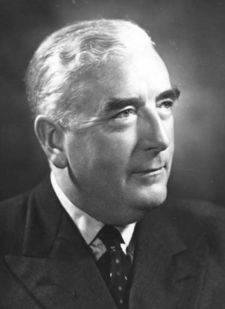 |
|
|
12th Prime Minister of Australia
Elections: 1940, 1949—1963 |
|
|---|---|
| In office 26 April 1939 – 26 August 1941 |
|
| Monarch | King George VI |
| Preceded by | Earle Page |
| Succeeded by | Arthur Fadden |
| In office 19 December 1949 – 26 January 1966 |
|
| Monarch | King George VI Queen Elizabeth II |
| Preceded by | Ben Chifley |
| Succeeded by | Harold Holt |
|
Member of the Australian Parliament
for Kooyong |
|
| In office 15 September 1934 – 2 April 1966 |
|
| Preceded by | John Latham |
| Succeeded by | Andrew Peacock |
|
Deputy Premier of Victoria
|
|
| In office May 1932 – July 1934 |
|
| Preceded by | Albert Dunstan |
| Succeeded by | Wilfrid Kent Hughes |
| Constituency | Nunawading |
|
|
|
| Born | 20 December 1894 Jeparit, Victoria |
| Died | 15 May 1978 (aged 83) Melbourne, Victoria |
| Political party | Liberal Party of Australia |
| Spouse(s) | Pattie Leckie |
| Religion | Presbyterian |
Sir Robert Gordon Menzies, KT, AK, CH, FAA, FRS, QC (20 December 1894 – 15 May 1978), Australian politician, was the 12th and longest-serving Prime Minister of Australia.
His first term as Prime Minister commenced in 1939, after the death in office of the United Australia Party leader Joseph Lyons and a short-term interim premiership by Sir Earle Page. His party narrowly won the 1940 election, which produced the first hung parliament in Australian history, with the support of independent MPs in the House. A year later, his government was brought down by those same MPs crossing the floor. He spent eight years in opposition, during which he founded the Liberal Party of Australia. He again became Prime Minister at the 1949 election, and he then dominated Australian politics until his retirement in 1966.
Menzies was renowned as a brilliant speaker, both on the floor of Parliament and on the hustings; his speech "The Forgotten People" is an example of his oratorical skills. Throughout his life and career, Menzies held strong beliefs in the Monarchy and in traditional ties with Britain. In 1963 Menzies was invested as the first and only Australian Knight of the Order of the Thistle. Menzies is regarded highly in Prime Ministerial opinion polls and is very highly regarded in Australian society for his tenures as Prime Minister.
Contents |
Early life
Robert Gordon Menzies was born to James Menzies and Kate Menzies (née Sampson) in Jeparit, a town in the Wimmera region of western Victoria, on 20 December 1894. His father James was a storekeeper, the son of Scottish crofters who had immigrated to Australia in the mid-1850s in the wake of the Victorian gold rush. His maternal grandfather, John Sampson, was a Cornish miner from Penzance who also came to seek his fortune on the gold-fields, in Ballarat.[1] His father and one of his uncles had been members of the Victorian Parliament, while another uncle had represented Wimmera in the House of Representatives.[2] He was proud of his Highland ancestry – his enduring nick-name, Ming, came from /ˈmɪŋəs/, the Scots — and his own preferred — pronunciation of Menzies. His middle name, Gordon, was given to him in honour and memory of Charles George Gordon, a British army officer killed in Khartoum in 1885.[3]
Menzies was first educated at a one-room school, then later at private schools in Ballarat and Melbourne (Wesley College), and studied law at the University of Melbourne graduating in 1916.
When World War I began, Menzies was 19 years old and held a commission in the university's militia unit. Menzies resigned his commission at the very time others of his age and class clamoured to be allowed to enlist. It was later stated that, since the family had made enough of a sacrifice to the war with the enlistment of two of three eligible brothers, Menzies should stay to finish his studies.[2] Menzies himself never explained the reason why he chose not to enlist. Subsequently he was prominent in undergraduate activities and won academic prizes and declared himself to be a patriotic supporter of the war and conscription.[4] Menzies was admitted to the Victorian Bar and to the High Court of Australia in 1918 and soon became one of Melbourne's leading lawyers after establishing his own practice. In 1920 he married Pattie Leckie, the daughter of federal Nationalist, and later Liberal, MP, John Leckie; she was reportedly a moderating influence on him.
Rise to power
In 1928, Menzies gave up his law practice to enter state parliament as a member of the Victorian Legislative Council representing the Nationalist Party of Australia. His candidacy was nearly defeated when a group of ex-servicemen attacked him in the press for not having enlisted, but he survived this crisis. The following year he shifted to the Legislative Assembly, and was a minister in the conservative Victorian government from 1932 to 1934, and became Deputy Premier of Victoria from in May 1932 until July 1934.
In 1931 the United Australia Party won the election, and Joseph Lyons became Federal Prime Minister. By 1934 he could only hold power by coalition with the Country Party, whose leader Sir Earle Page became deputy Prime Minister. Menzies entered federal politics in 1934, representing the United Australia Party (UAP) in the upper-class Melbourne electorate of Kooyong. He was immediately appointed Attorney-General and Minister for Industry in the Lyons government. In 1937 he was appointed a Privy Councillor
In late 1934 and early 1935 Menzies unsuccessfully prosecuted the Lyons government's case for the attempted exclusion from Australia of Egon Kisch, a Czech Jewish communist. Because of this, some accused Menzies of being pro-Nazi, whilst others saw it as an early example of his strong opposition to communism. Following the outbreak of World War 2 Menzies found it necessary to distance himself from the controversy by claiming Interior Minister Thomas Paterson was responsible since he made the initial order to exclude Kisch.
Animosity developed between Page and Menzies which was aggravated when Page became Acting Prime Minister during Lyons' illness after October 1938. Menzies and Page attacked each other publicly. He later became deputy leader of the UAP. His supporters said he was Lyons's natural successor; his critics accused Menzies of wanting to push Lyons out, a charge he denied. In 1938 his enemies ridiculed him as "Pig Iron Bob", the result of his industrial battle with waterside workers who refused to load scrap iron being sold to Imperial Japan. In 1939, however, he resigned from the Cabinet in protest at postponement of the national insurance scheme. With Lyons' sudden death on 7 April 1939, Page became Prime Minister until the United Australia Party could elect a leader. Menzies was elected on 18 April, and Page and his Country Party left the coalition. After war broke out in September 1939 the Country Party persuaded Page to resign from party leadership, which enabled the coalition to resume. But in August 1941 Menzies was overthrown by his own UAP and Arthur Fadden (Country Party leader) took over the premiership. When two independents crossed the floor to join Labor, the Government fell, and eight years of Labor Government followed. The United Australia Party collapsed and was later reorganized by Menzies as the Liberal Party[5].
First term as Prime Minister
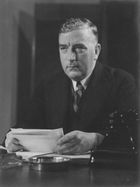
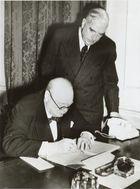
On 26 April 1939, following a period during which the Country Party leader, Sir Earle Page, was caretaker Prime Minister, Menzies was elected Leader of the UAP and was sworn in as Prime Minister. A crisis arose almost immediately, however, when Page refused to serve under him. In an extraordinary personal attack in the House, Page accused Menzies of cowardice for not having enlisted in the War, and of treachery to Lyons. Menzies then formed a minority government. When Page was deposed as Country Party leader a few months later, Menzies reformed the Coalition with Page's successor, Archie Cameron.
| “ | "Fellow Australians, It is my melancholy duty to inform you officially that in consequence of a persistence by Germany in her invasion of Poland, Great Britain has declared war upon her and that, as a result, Australia is also at war." | ” |
- Menzies radio broadcast to the nation on 3 September 1939 informing Australia that the country was at war with Germany and her allies.[6]
In September 1939, Menzies found himself a wartime leader of a small nation of 7 million people that depended on Britain for defense against the looming threat of the Japanese Empire, with 100 million people, a very powerful military, and an aggressive foreign policy that looked south. He did his best to rally the country, but the bitter memories of the disillusionment which followed the First World War made this difficult. Added to this was the fact that Menzies had not served in that war, and that as Attorney-General and Deputy Prime Minister, Menzies had made an official visit to Germany in 1938, and like his Opposition at the time, supported Neville Chamberlain's policy of Appeasement. At the 1940 election, the UAP was nearly defeated, and Menzies' government survived only thanks to the support of two independent MPs, Arthur Coles and Alex Wilson. The Australian Labor Party (ALP), under John Curtin, refused Menzies' offer to form a war coalition, and also opposed using the Australian army for a European war, preferring to keep it at home to defend Australia. The ALP did agree to participate in the Advisory War Council, however. Menzies sent the bulk of the army to help the British in the Middle East and Singapore, and told Churchill the Royal Navy should strengthen its Far Eastern forces[7].
In 1941 Menzies spent months in Britain discussing war strategy with Winston Churchill and other leaders, while his position at home deteriorated. The Australian historian David Day has suggested that Menzies hoped to replace Churchill as British Prime Minister, and that he had some support in Britain for this. Other Australian writers, such as Gerard Henderson, have rejected this theory. When Menzies came home, he found he had lost all support, and was forced to resign, first, on 28 August, as Prime Minister, and then as UAP leader. The Country Party leader, Arthur Fadden, became Prime Minister. Menzies was very bitter about what he saw as this betrayal by his colleagues, and almost left politics.
Return to power
Extract; The Forgotten People, Robert Menzies, 22 May 1942;
| “ | "I do not believe that the real life of this nation is to be found either in great luxury hotels and the petty gossip of so-called fashionable suburbs, or in the officialdom of the organised masses. It is to be found in the homes of people who are nameless and unadvertised, and who, whatever their individual religious conviction or dogma, see in their children their greatest contribution to the immortality of their race. The home is the foundation of sanity and sobriety; it is the indispensable condition of continuity; its health determines the health of society as a whole." [8] | ” |
Labor came to power later in October 1941 under John Curtin, following the defeat of the Fadden government in Parliament. In 1943 Curtin won a huge election victory. During 1944 Menzies held a series of meetings at 'Ravenscraig' an old homestead in Aspley to discuss forming a new anti-Labor party to replace the moribund UAP. This was the Liberal Party, which was launched in early 1945 with Menzies as leader. But Labor was firmly entrenched in power and in 1946 Curtin's successor, Ben Chifley, was comfortably re-elected. Comments that "we can't win with Menzies" began to circulate in the conservative press.
Over the next few years, however, the anti-communist atmosphere of the early Cold War began to erode Labor's support. In 1947, Chifley announced that he intended to nationalise Australia's private banks, arousing intense middle-class opposition which Menzies successfully exploited. The 1949 coal strike, engineered by the Communist Party, also played into Menzies' hands. In the December 1949 election, Menzies won power for the second time in a massive landslide, scoring a 48-seat swing—still the largest defeat of a sitting government at the federal level in Australia. In 1950 Menzies was awarded the Legion of Merit (Chief Commander) by U.S. President Harry S. Truman for "exceptionally meritorious conduct in the performance of outstanding services 1941–1944 and December 1949 – July 1950".
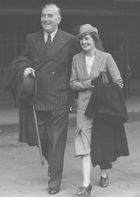
Although Menzies had a comfortable majority in the House, the ALP-controlled Senate made life very difficult for him. In 1951 Menzies introduced legislation to ban the Communist Party, hoping that the Senate would reject it and give him an excuse for a double dissolution election, but Labor let the bill pass. It was subsequently ruled unconstitutional by the High Court. But when the Senate rejected his banking bill, he called a double dissolution and at the election won control of both Houses.
Later in 1951 Menzies decided to hold a referendum on the question of changing the Constitution to permit the parliament to make laws in respect of Communists and Communism where he said this was necessary for the security of the Commonwealth. If passed, this would have given a government the power to introduce a bill proposing to ban the Communist Party (although whether it would have passed the Senate is an open question). The new Labor leader, Dr H. V. Evatt, campaigned against the referendum on civil liberties grounds, and it was narrowly defeated. This was one of Menzies' few electoral miscalculations. He sent Australian troops to the Korean War and maintained a close alliance with the United States.
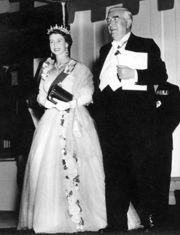
Economic conditions, however, deteriorated, and Evatt was confident of winning the 1954 elections. Shortly before the elections, Menzies announced that a Soviet diplomat in Australia Vladimir Petrov, had defected, and that there was evidence of a Soviet spy ring in Australia, including members of Evatt's staff. This Cold War scare enabled Menzies to win the election; although Labor won a majority of the two-party-preferred vote, it was unable to take enough seats from the Coalition to topple Menzies. Evatt accused Menzies of arranging Petrov's defection, but this has since been disproved: he had simply taken advantage of it.
The aftermath of the 1954 election caused a split in the Labor Party, with several anti-Communist members from Victoria defecting to form the Australian Labor Party (Anti-Communist). The new party directed its preferences to the Liberals, and Menzies was comfortably re-elected over Evatt in 1955. Menzies was reelected almost as easily in 1958, again with the help of preferences from what had become the Democratic Labor Party. By this time the post-war economic recovery was in full swing, fuelled by massive immigration and the growth in housing and manufacturing that this produced. Prices for Australia's agricultural exports were also high, ensuring rising incomes.
Labor's new leader, Arthur Calwell, gave Menzies a scare after an ill-judged squeeze on credit – an effort to restrain inflation – caused a rise in unemployment. At the 1961 election Menzies was returned with a majority of only two seats. But Menzies was able to exploit Labor's divisions over the Cold War and the American alliance, and win an increased majority in the 1963 election.
An incident in which Calwell was photographed standing outside a South Canberra hotel while the ALP Federal Executive (dubbed by Menzies the "36 faceless men") was determining policy also contributed to the 1963 victory. This was the first "television election," and Menzies, although nearly 70, proved a master of the new medium. Menzies' policy speech was televised on 12 November 1963, a method that "had never before been used in Australia".[9] The effect of this form of political communication was studied by Colin Hughes and John Western, who published their findings in 1966. This was itself the first such detailed study in Australia.[9]
In 1963, Menzies was appointed a Knight of the Order of the Thistle (KT),[10] the order being chosen in recognition of his Scottish heritage. He is the only Australian ever appointed to this order, although three British governors-general of Australia (Lord Hopetoun; Sir Ronald Munro Ferguson, later Lord Novar; and Prince Henry, Duke of Gloucester) were members. He was the second of only two Australian prime ministers to be knighted during their term of office (the first prime minister Edmund Barton was knighted during his term in 1902).
In 1965, Menzies committed Australian troops to the Vietnam War, and also to reintroduce conscription. These moves were initially popular, but later became a problem for his successors.
Despite his pragmatic acceptance of the new power balance in the Pacific after World War II and his strong support for the American alliance, he publicly professed continued admiration for links with Britain, exemplified by his admiration for Queen Elizabeth II, and famously described himself as "British to the bootstraps". Over the decade, Australia's ardour for Britain and the monarchy faded somewhat, but Menzies's had not. At a function attended by the Queen at Parliament House, Canberra, in 1963, Menzies quoted the Elizabethan poet Thomas Ford, "I did but see her passing by, and yet I love her till I die".
Retirement and Legacy
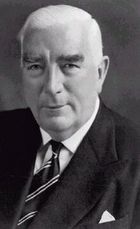
Menzies retired on Australia Day, 26 January 1966, and was succeeded as Liberal Party leader and Prime Minister by his former Treasurer, Harold Holt. Although the coalition remained in power for almost another seven years (until the 1972 Federal election), it did so under four different Prime Ministers.
On his retirement he became the thirteenth Chancellor of his old University of Melbourne, and remained the head of the University from March 1967 until March 1972. Much earlier in 1942, he had received the first honorary degree of Doctor of Laws of Melbourne University. His responsibility for the revival and growth of university life in Australia was widely acknowledged by the award of honorary degrees in the Universities of Queensland, Adelaide, Tasmania, New South Wales, and the Australian National University and by thirteen universities in Canada, the U.S.A. and Britain, including Oxford and Cambridge. Many learned institutions, including the Royal College of Surgeons (Hon. FRCS) and the Royal Australasian College of Physicians (Hon. FRACP), elected him to Honorary Fellowships, and the Australian Academy of Science, for which he supported its establishment in 1954, made him a fellow (FAAS) in 1958.
In July 1966 the Queen appointed Menzies to the ancient office of Lord Warden of the Cinque Ports and Constable of Dover Castle, taking official residence at Walmer Castle during his annual visits to Britain. He toured the United States giving lectures, and he published two volumes of memoirs. At the end of 1966 Menzies took up a scholar-in-residence position at the University of Virginia. Menzies encountered some public tribulation in retirement; however, when he suffered strokes in 1968 and 1971, he faded from public view.
Menzies died from a heart attack in Melbourne in 1978 and was accorded a state funeral, held in Scots' Church, Melbourne, at which Prince Charles represented Queen Elizabeth II.[11]
Menzies was Prime Minister for a total of 18 years, five months, and 12 days, by far the longest term of any Australian Prime Minister, and during his second term he dominated Australian politics as no one else has ever done. He managed to live down the failures of his first term in office, and to rebuild the conservative side of politics from the nadir it hit in 1943. Menzies also did much to develop higher education in Australia, and he also made the increasing development of Canberra one of his big projects.
However, it can also be noted that while retaining government on each occasion, Menzies lost the two-party-preferred vote in 1940, 1954, and 1961.
He was the only Australian Prime Minister to recommend the appointment of four governors-general (Sir William Slim, and Lords Dunrossil, De L'Isle, and Casey). Only two other Prime Ministers have ever chosen more than one governor-general. (Malcolm Fraser chose Sir Zelman Cowen and Sir Ninian Stephen; and John Howard chose Peter Hollingworth and Michael Jeffery.)
Critics say that Menzies's success was mainly due to the good luck of the long post-war boom and his manipulation of the anti-communist fears of the Cold War years, both of which he exploited with great skill. He was also crucially aided by the crippling dissent within the Labor Party in the 1950s and especially by the ALP split of 1954.
Several books have been filled with anecdotes about him and with his many witty remarks. While he was speaking in Williamstown, Victoria, in 1954, a heckler shouted, "I wouldn’t vote for you if you were the Archangel Gabriel" – to which Menzies coolly replied "If I were the Archangel Gabriel, I’m afraid you wouldn't be in my constituency."
Planning for an official biography of Menzies began soon after his death, but it was long delayed by Dame Pattie Menzies' protection of her husband's reputation and her refusal to co-operate with the appointed biographer, Frances McNicoll. In 1991, the Menzies family appointed Professor A.W. Martin to write a biography, which appeared in two volumes, in 1993 and 1999.
Titles and honours
- On 1 January 1951 he was appointed to the Order of the Companions of Honour (CH)[12]
- On 29 August 1952, the University of Sydney conferred the degree of Doctor of Laws (honoris causa) on Menzies.[13] He was likewise awarded an Honorary Doctor of Laws by the Universities of Bristol, Belfast, Melbourne, British Columbia, McGill, Montreal, Royal University of Malta, Laval, Quebec, Tasmania, Cambridge, Harvard, Leeds, Adelaide, Queensland, Edinburgh, Birmingham, Drury and California.[14] On 29 April 1964 Menzies was presented with the honorary degree of a Doctor of Letters (DLitt) by the University of Western Australia.[15] Menzies was also awarded with an Honorary Doctor of Science by the University of New South Wales.[14]
- In 1973 Menzies was awarded Japan's Order of the Rising Sun, Grand Cordon, First Class (other Australian Prime Ministers to be awarded this honour were Edmund Barton, John McEwen, Malcolm Fraser and Gough Whitlam).[16]
- On 7 June 1976, he was appointed a Knight of the Order of Australia (AK). The category of Knight of the order had been created only on 24 May, and the Chancellor and Principal Knight of the Order, the Governor-General Sir John Kerr, became the first appointee, ex officio. Menzies' was the first appointment made after this.
Styles from birth
Styles and titles Menzies Menzies held held from birth until death, in chronological order:
- Mr Robert Menzies (20 December 1896–1928)
- The Hon. Robert Menzies, MLC (1928–1929)
- The Hon. Robert Menzies, MLA (1929–1929)
- The Hon. Robert Menzies, KC, MLA (1929–1934)
- The Hon. Robert Menzies, KC, MP (1934–1937)
- The Rt Hon. Robert Menzies, KC, MP (1937–1951)
- The Rt Hon. Robert Menzies, CH, KC, MP (1951–1952)
- The Rt Hon. Robert Menzies, CH, QC, MP (1952–1958)
- The Rt Hon. Robert Menzies, CH, FAA, QC, MP (1958–1963)
- The Rt Hon. Sir Robert Menzies, KT, CH, FAA, QC, MP (1963–1965)
- The Rt Hon. Sir Robert Menzies, KT, CH, FAA, FRS, QC, MP (1965–1966)
- The Rt Hon. Sir Robert Menzies, KT, CH, FAA, FRS, QC (1966–1976)
- The Rt Hon. Sir Robert Menzies, KT, AK, CH, FAA, FRS, QC (1976 – 15 May 1978)
See also
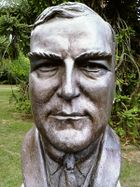
- First Menzies Ministry
- Second Menzies Ministry
- Third Menzies Ministry
- Fourth Menzies Ministry
- Fifth Menzies Ministry
- Sixth Menzies Ministry
- Seventh Menzies Ministry
- Eighth Menzies Ministry
- Ninth Menzies Ministry
- Tenth Menzies Ministry
Actors who have played Menzies
- In the 1984 mini series The Last Bastion, Menzies was portrayed by John Wood.
- In the 1987 mini series Vietnam, he was portrayed by Noel Ferrier.
- In the 1988 mini series True Believers, he was portrayed by John Bonney.
- In the 2007 film Curtin, he was portrayed by Bille Brown.
- Max Gillies has caricatured Menzies on stage and in the comedy satire series The Gillies Report.
Eponyms of Menzies
- Sir Robert Menzies Memorial Foundation
- Menzies School of Health Research Australia
- R. G. Menzies Building, Australian National University Library
- The Menzies Research Centre Ltd.
- Menzies College (La Trobe University)
- Robert Menzies College (Macquarie University)
- Sir Robert Menzies Building (Monash University, Clayton Campus)
- The Australian federal electoral division of Menzies.[17]
- Menzies Wing (Wesley College, Melbourne)
Further reading
- Brett, Judith (1992) Robert Menzies' Forgotten People, Macmillan, (a sharply critical psychological study)
- Cook, Ian (1999), Liberalism in Australia, Oxford University Press, South Melbourne, Victoria, Ch. 7 'Robert Menzies'. ISBN 019 553 702 5
- Hazlehurst, Cameron (1979), Menzies Observed, George Allen and Unwin, Sydney, New South Wales. ISBN 0 86861 320 7
- Hughes, Colin A (1976), Mr Prime Minister. Australian Prime Ministers 1901–1972, Oxford University Press, Melbourne, Victoria, Chs. 13 and 18. ISBN 0 19 550471 2
- Martin, Allan (1993 and 1999) Robert Menzies: A Life, two volumes, Melbourne University Press, Carlton, Victoria.
- Martin, Allan (2000), 'Sir Robert Gordon Menzies,' in Grattan, Michelle, "Australian Prime Ministers", New Holland Publishers, pages 174–205. (very good summary of his life and career) ISBN 1 86436 756 3
- Martin, A.W. (2000), "Menzies, Sir Robert Gordon (Bob) (1894 – 1978)", Australian Dictionary of Biography, Volume 15, Melbourne University Press, (Melbourne), pp 354–361.[18]
- Starr, Graeme (1980), The Liberal Party of Australia. A Documentary History, Drummond/Heinemann, Richmond, Victoria. ISBN 0 85859 223 1
Notes and references
- ↑ Australian Academy of Science: Biographical Memoirs of Deceased Fellows: Robert Gordon Menzies 1894–1978
- ↑ 2.0 2.1 Australia's Prime Ministers website: Robert Menzies
- ↑ Manning Clark, Manning Clark's History of Australia, Pimlico, 1995, p.468, ISBN 0-7126-6205-7. Gordon's death had stirred a lasting movement of imperialist patriotism in Australia. Ibid, p.372.
- ↑ [1]
- ↑ George Fairbanks, "Menzies becomes Prime Minister, 1939," Australian Quarterly, 1968, Vol. 40 Issue 2, pp 18-30,
- ↑ MVM 1939 – Declaration of War
- ↑ Paul Hasluck, the Government and the People: 1939-1941 (1951)
- ↑ The Forgotten People – Speech by Robert Menzies on 22 May, 1942. Liberals.Net: Liberal Party of Australia
- ↑ 9.0 9.1 Hughes, Colin A; Western, John S (1966), The Prime Minister's Policy Speech: A Case Study in Televised Politics, Canberra: Ausralian National University Press, p. bookcover & p.1
- ↑ London Gazette: no. 42964, p. 3155, 9 April 1963. Retrieved 30 October 2008.
- ↑ "Prince here tomorrow - Rush trip to Menzies funeral". The Age (Melbourne): p. 1. May 17, 1978. http://news.google.com/newspapers?nid=MDQ-9Oe3GGUC&dat=19780517&printsec=frontpage. Retrieved 12 August 2010.
- ↑ "Its an Honour: CH". Australian Government. http://www.itsanhonour.gov.au/honours/honour_roll/search.cfm?aus_award_id=1065985&search_type=simple&showInd=true. Retrieved 2009-10-15.
- ↑ "The Right Honourable Robert Gordon Menzies". University of Sydney. http://www.usyd.edu.au/senate/committees/advisoryMenzies.shtml#Citation. Retrieved 2009-10-15.
- ↑ 14.0 14.1 "University Secretary's Department – Former Office-Bearers". University of Melbourne. http://www.unimelb.edu.au/unisec/calendar/formoffi.html. Retrieved 2009-10-15.
- ↑ "Speech by Sir Robert Menzies in Winthrop Hall, University of Western Australia". University of Western Australia. http://catalogue.nla.gov.au/Record/1966316. Retrieved 2009-10-15.
- ↑ Honor awarded 1973 – National Archives of Australia
- ↑ [http://www.aec.gov.au/Electorates/Electoral_DPM /Origin_Current_Division.htm Origins of Current Divisions Name – Current Divisions], Australian Electoral Commission web site
- ↑ "Menzies, Sir Robert Gordon (Bob) (1894–1978) Biographical Entry – Australian Dictionary of Biography Online". Adb.online.anu.edu.au. http://www.adb.online.anu.edu.au/biogs/A150416b.htm?hilite=menzies. Retrieved 2010-04-16.
External links
- "Robert Menzies". Australia's Prime Ministers. National Archives of Australia. http://primeministers.naa.gov.au/primeministers/menzies/. Retrieved 29 June 2010.
- Martin, A. W. (2000). "Menzies, Sir Robert Gordon (Bob) (1894–1978)". Australian Dictionary of Biography. Australian National University. http://www.adb.online.anu.edu.au/biogs/A150416b.htm. Retrieved 29 June 2010.
- "Robert Menzies". National Museum of Australia. http://www.nma.gov.au/education/school_resources/websites_and_interactives/primeministers/robert_menzies/. Retrieved 29 June 2010.
- The Menzies Foundation
- The Menzies Virtual Museum
- The Menzies Centre for Australian Studies, London
- The Liberal Party's Robert Menzies website
- The Legacy of Sir Robert Menzies National Library of Australia
- Sir Robert Menzies at the National Film and Sound Archive
| Victorian Legislative Council | ||
|---|---|---|
| Preceded by James Merritt |
Member for East Yarra Province 1928 – 1929 |
Succeeded by Sir Clifden Eager |
| Victorian Legislative Assembly | ||
| Preceded by Edmund Greenwood |
Member for Nunawading 1929 – 1934 |
Succeeded by William Boyland |
| Political offices | ||
| Preceded by Sir Albert Dunstan |
Deputy Premier of Victoria 1932 – 1934 |
Succeeded by Sir Wilfrid Kent Hughes |
| Parliament of Australia | ||
| Preceded by John Latham |
Member for Kooyong 1934 – 1966 |
Succeeded by Andrew Peacock |
| Political offices | ||
| Preceded by John Latham |
Minister for Industry 1934 – 1939 |
Succeeded by Billy Hughes |
| Attorney-General of Australia 1934 – 1938 |
||
| Preceded by Earle Page |
Prime Minister of Australia 1939 – 1941 |
Succeeded by Arthur Fadden |
| Preceded by Geoffrey Street |
Minister for Defence Coordination 1939 – 1941 |
Succeeded by John Curtin |
| Preceded by Richard Casey |
Treasurer of Australia 1940 – 1941 |
Succeeded by Percy Spender |
| Preceded by John Lawson |
Minister for Trade and Customs 1940 |
Succeeded by George McLeay |
| New title | Minister for Munitions 1940 |
Succeeded by Philip McBride |
| Preceded by Arthur Fadden |
Leader of the Opposition of Australia 1943 – 1949 |
Succeeded by Ben Chifley |
| Preceded by Ben Chifley |
Prime Minister of Australia 1949 – 1966 |
Succeeded by Harold Holt |
| Preceded by Enid Lyons |
Vice-President of the Executive Council 1951 |
Succeeded by Eric Harrison |
| Preceded by Richard Casey |
Minister for Foreign Affairs 1960 – 1961 |
Succeeded by Garfield Barwick |
| Preceded by Donald Cameron |
Minister in charge of the Commonwealth Scientific and Industrial Research Organisation 1961 – 1962 |
Succeeded by John Gorton |
| Party political offices | ||
| Preceded by Joseph Lyons |
Leader of the United Australia Party 1939 – 1941 |
Succeeded by Billy Hughes |
| Preceded by Billy Hughes |
Leader of the United Australia Party 1943 – 1945 |
Party disbanded |
| New political party | Leader of the Liberal Party of Australia 1945 – 1966 |
Succeeded by Harold Holt |
| Honorary titles | ||
| Preceded by Sir Winston Churchill |
Lord Warden of the Cinque Ports 1966 – 1978 |
Succeeded by Queen Elizabeth, the Queen Mother |
| Academic offices | ||
| Preceded by Sir William Upjohn |
Chancellor of the University of Melbourne 1967 – 1972 |
Succeeded by Leonard Weickhardt |
|
|||||
|
|||||
|
|||||